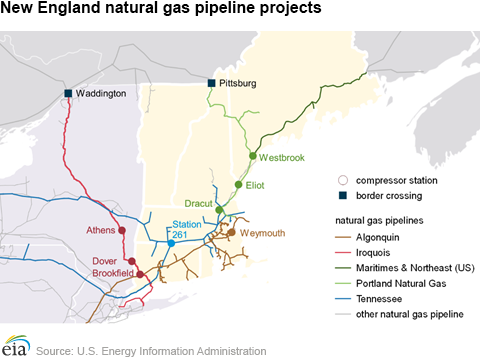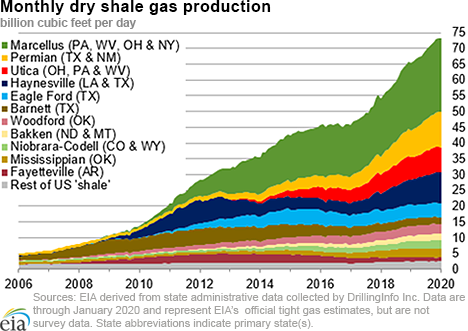In the News:
Pipelines plan to increase natural gas deliverability into New England by upgrading existing infrastructure
Several natural gas pipeline upgrades are either planned or under construction in New England, which will increase deliverability into the region over the next several years. According to the U.S. Energy Administration’s (EIA) tracking of natural gas pipeline projects, four pipelines are expected to increase compression in their system by 2023, adding more than 350 million cubic feet per day (MMcf/d) of natural gas pipeline capacity into the region.
As of the end of 2019, EIA estimates pipeline capacity into New England from both Canada and New York was 5,200 MMcf/d. During days of peak demand in the winter, most of this capacity is fully utilized, which can lead to spikes in spot natural gas and, in turn, electricity prices. These projects aim to ease the pipeline constraints into New England.
The largest of these pipeline upgrade projects, which submitted its application to the Federal Energy Regulatory Commission (FERC) on February 4, is Iroquois pipeline’s Iroquois Enhancement by Compression Project. By increasing the horsepower at three compression stations in New York and Connecticut, Iroquois pipeline will increase its capacity by 125 MMcf/d. The border crossing at Waddington in upstate New York, which connects to the TransCanada Mainline, is already designed to supply these additional volumes. If approved, the project is expected to start construction in spring 2023 and be placed in service by November of that year.
On the Portland Natural Gas Transmission System, two projects will increase the volumes of Canadian natural gas imports received from the TransQuébec and Martimes pipelines at Pittsburg, New Hampshire: Portland Xpress Project Phase III, adding 24 MMcf/d capacity in 2020, and the Westbrook Xpress Project Phase II, adding 63 MMcf/d after its expected completion in 2021. The previous phases of both projects have already entered service, and both projects only require modifications or upgrades at existing compressor stations.
In addition, two other projects will increase natural gas deliverability to New England from New York:
- Algonquin’s Atlantic Bridge Phase II project will add 92.7 MMcf/d of additional capacity further into New England when the Weymouth compressor station is completed in Massachusetts. The project, which has faced numerous delays, is expected to enter service either later in 2020 or in 2021.
- Tennessee Gas Pipeline’s Station 261 Upgrade Projects will provide an additional 72 MMcf/d of capacity. This project is expected to enter service in 2020 and involves upgrading compressor station 261 and 2.1 miles of looping adjacent to the site.
Overview:
(For the week ending Wednesday, March 4, 2020)
- Natural gas spot prices fell at most locations this report week (Wednesday, February 26 to Wednesday, March 4). The Henry Hub spot price fell from $1.92 per million British thermal units (MMBtu) last Wednesday to $1.80/MMBtu yesterday.
- At the New York Mercantile Exchange (Nymex), the March 2020 contract expired last Wednesday at $1.821/MMBtu. The April 2020 contract price decreased to $1.827/MMBtu, down 1¢/MMBtu from last Wednesday to yesterday. The price of the 12-month strip averaging April 2020 through March 2021 futures contracts declined 1¢/MMBtu to $2.157/MMBtu.
- The net withdrawal from working gas totaled 109 billion cubic feet (Bcf) for the week ending February 28. Working natural gas stocks total 2,091 Bcf, which is 48% more than the year-ago level and 9% more than the five-year (2015–19) average for this week.
- The natural gas plant liquids composite price at Mont Belvieu, Texas, fell by 33¢/MMBtu, averaging $4.30/MMBtu for the week ending March 4. The prices of butane, natural gasoline, propane, and isobutane fell by 17%, 12%, 5%, and 4%, respectively. The price of ethane remained flat week over week.
- According to Baker Hughes, for the week ending Tuesday, February 25, the natural gas rig count remained flat at 110. The number of oil-directed rigs fell by 1 to 678. The total rig count decreased by 1, and it now stands at 790.
Prices/Supply/Demand:
Prices are down with other commodities. This report week (Wednesday, February 26 to Wednesday, March 4), the Henry Hub spot price fell 12¢ from $1.92/MMBtu last Wednesday to $1.80/MMBtu yesterday after reaching a low of $1.70/MMBtu on Monday. Temperatures that were generally warmer than normal across the Lower 48 states and decreased demand in global energy markets due to worldwide economic concerns put downward pressure on domestic prices.
At the Chicago Citygate, the price decreased 10¢ from $1.76/MMBtu last Wednesday to $1.66/MMBtu yesterday. The price at SoCal Citygate in Southern California decreased 18¢ from a high of $2.20/MMBtu last Wednesday to $2.02/MMBtu yesterday. The price at PG&E Citygate in Northern California rose 3¢, up from $2.65/MMBtu last Wednesday to a high of $2.68/MMBtu yesterday.
Northeast prices are down. At the Algonquin Citygate, which serves Boston-area consumers, the price went down 42¢ from $2.11/MMBtu last Wednesday to $1.69/MMBtu yesterday after reaching a low of $1.60/MMBtu on Monday. At the Transcontinental Pipeline Zone 6 trading point for New York City, the price decreased 24¢ from $1.90/MMBtu last Wednesday to $1.66/MMBtu yesterday after reaching a low of $1.53/MMBtu on Monday.
The Tennessee Zone 4 Marcellus spot price decreased 15¢ from $1.60/MMBtu last Wednesday to $1.45/MMBtu yesterday. The price at Dominion South in southwest Pennsylvania fell 14¢ from $1.65/MMBtu last Wednesday to $1.51/MMBtu yesterday.
Permian Basin prices trade in negative territory for two days this report week. The price at the Waha Hub in West Texas, which is located near Permian Basin production activities, averaged $0.36/MMBtu last Wednesday, $1.56/MMBtu lower than the Henry Hub price. Yesterday, the price at the Waha Hub averaged $0.29/MMBtu, $1.51/MMBtu lower than the Henry Hub price. Prices reached a low of -$0.67/MMBtu on Monday.
Supply falls. According to data from IHS Markit, the average total supply of natural gas fell by 1% compared with the previous report week. Dry natural gas production remained unchanged week over week. Average net imports from Canada decreased by 11% from last week amid warmer-than-normal temperatures in Northeast and Midwestern markets.
Demand falls, driven by declines for heating demand in buildings. Total U.S. consumption of natural gas fell by 8% compared with the previous report week, according to data from IHS Markit. In the residential and commercial sectors, consumption declined by 14%. Natural gas consumed for power generation declined by 4% week over week. Industrial sector consumption decreased by 3% week over week. Natural gas exports to Mexico increased 3%.
U.S. LNG exports decrease week over week. Fifteen LNG vessels (six from Sabine Pass, three from Freeport, and two each from Corpus Christi, Cameron, and Cove Point) with a combined LNG-carrying capacity of 53 Bcf departed the United States between February 27 and March 4, 2020, according to shipping data compiled by Bloomberg. Two vessels were loading at the Sabine Pass terminal on Wednesday.
Elba Island LNG, located near Savannah, Georgia, received a letter order from the Federal Energy Regulatory Commission authorizing the facility to “commence service for liquefaction and export activities from the Moveable Modular Liquefaction System No. 5.” Elba Island LNG began commercial operation on September 30, 2019, and has exported three LNG cargoes so far.
Storage:
The net withdrawal from storage totaled 109 Bcf for the week ending February 28, compared with the five-year (2015–19) average net withdrawal of 106 Bcf and last year's net withdrawal of 152 Bcf during the same week. Working natural gas stocks totaled 2,091 Bcf, which is 176 Bcf more than the five-year average and 680 Bcf more than last year at this time.
According to The Desk survey of natural gas analysts, estimates of the weekly net change to working natural gas stocks ranged from a net withdrawal of 96 Bcf to 117 Bcf, with a median estimate of 109 Bcf.
The average rate of withdrawal from storage is 8% lower than the five-year average so far in the withdrawal season (November through March). If the rate of withdrawal from storage matched the five-year average of 6.8 Bcf/d for the remainder of the withdrawal season, the total inventory would be 1,873 Bcf on March 31, which is 176 Bcf higher than the five-year average of 1,697 Bcf for that time of year.
More storage data and analysis can be found on the Natural Gas Storage Dashboard and the Weekly Natural Gas Storage Report.
See also:
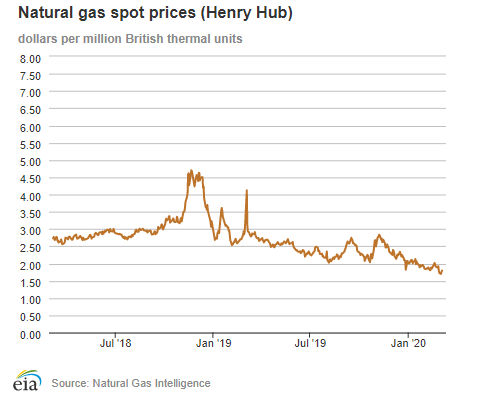
| Spot Prices ($/MMBtu) | Thu, 27-Feb |
Fri, 28-Feb |
Mon, 02-Mar |
Tue, 03-Mar |
Wed, 04-Mar |
|---|---|---|---|---|---|
| Henry Hub |
1.78 |
1.73 |
1.70 |
1.76 |
1.80 |
| New York |
1.78 |
1.67 |
1.53 |
1.65 |
1.66 |
| Chicago |
1.63 |
1.58 |
1.57 |
1.61 |
1.66 |
| Cal. Comp. Avg.* |
1.99 |
1.85 |
1.82 |
1.85 |
1.88 |
| Futures ($/MMBtu) | |||||
| April contract | 1.752 |
1.684 |
1.756 |
1.800 |
1.827 |
| May contract |
1.800 |
1.732 |
1.797 |
1.838 |
1.865 |
| *Avg. of NGI's reported prices for: Malin, PG&E Citygate, and Southern California Border Avg. | |||||
| Source: NGI's Daily Gas Price Index | |||||
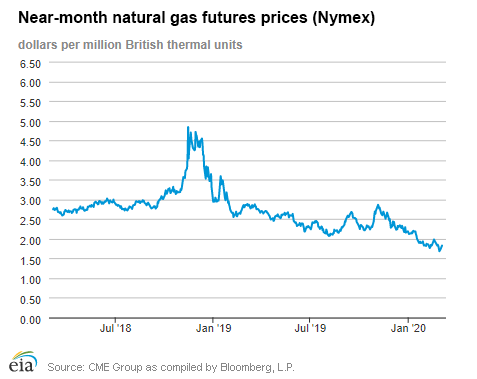
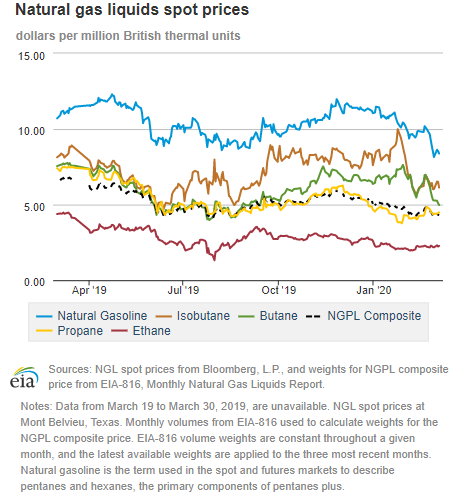
| U.S. natural gas supply - Gas Week: (2/27/20 - 3/4/20) | |||
|---|---|---|---|
Average daily values (Bcf/d): |
|||
this week |
last week |
last year |
|
| Marketed production | 106.4 |
106.7 |
99.7 |
| Dry production | 94.6 |
94.8 |
88.6 |
| Net Canada imports | 4.6 |
5.2 |
5.4 |
| LNG pipeline deliveries | 0.2 |
0.2 |
0.2 |
| Total supply | 99.4 |
100.1 |
94.2 |
|
Source: IHS Markit | |||
| U.S. natural gas consumption - Gas Week: (2/27/20 - 3/4/20) | |||
|---|---|---|---|
Average daily values (Bcf/d): |
|||
this week |
last week |
last year |
|
| U.S. consumption | 90.3 |
98.1 |
99.9 |
| Power | 29.8 |
31.0 |
29.3 |
| Industrial | 26.0 |
26.8 |
24.7 |
| Residential/commercial | 34.5 |
40.2 |
46.0 |
| Mexico exports | 5.5 |
5.4 |
4.8 |
| Pipeline fuel use/losses | 7.2 |
7.4 |
7.2 |
| LNG pipeline receipts | 8.1 |
8.8 |
5.4 |
| Total demand | 111.2 |
119.7 |
117.3 |
|
Source: IHS Markit | |||
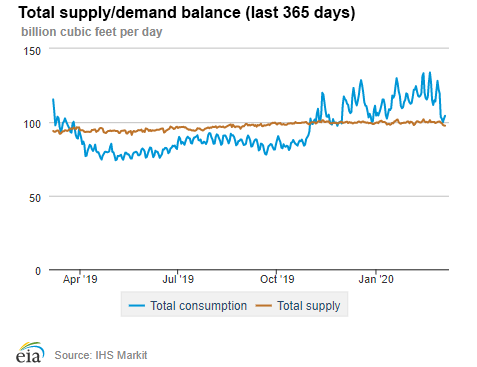
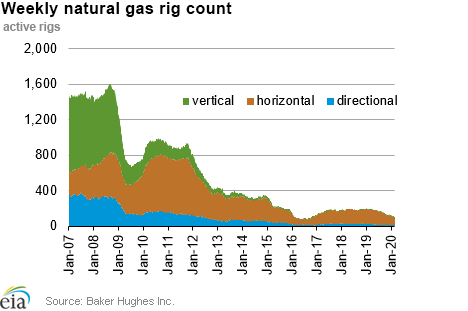
| Rigs | |||
|---|---|---|---|
Tue, February 25, 2020 |
Change from |
||
last week |
last year |
||
| Oil rigs | 678 |
-0.1% |
-19.6% |
| Natural gas rigs | 110 |
0.0% |
-43.6% |
| Note: Excludes any miscellaneous rigs | |||
| Rig numbers by type | |||
|---|---|---|---|
Tue, February 25, 2020 |
Change from |
||
last week |
last year |
||
| Vertical | 36 |
12.5% |
-40.0% |
| Horizontal | 708 |
-0.8% |
-22.3% |
| Directional | 46 |
2.2% |
-31.3% |
| Source: Baker Hughes Inc. | |||
| Working gas in underground storage | ||||
|---|---|---|---|---|
Stocks billion cubic feet (Bcf) |
||||
| Region | 2020-02-28 |
2020-02-21 |
change |
|
| East | 451 |
484 |
-33 |
|
| Midwest | 558 |
591 |
-33 |
|
| Mountain | 101 |
108 |
-7 |
|
| Pacific | 197 |
196 |
1 |
|
| South Central | 784 |
821 |
-37 |
|
| Total | 2,091 |
2,200 |
-109 |
|
|
Source: Form EIA-912, Weekly Underground Natural Gas Storage Report | ||||
| Working gas in underground storage | |||||
|---|---|---|---|---|---|
Historical comparisons |
|||||
Year ago (2/28/19) |
5-year average (2015-2019) |
||||
| Region | Stocks (Bcf) |
% change |
Stocks (Bcf) |
% change |
|
| East | 317 |
42.3 |
385 |
17.1 |
|
| Midwest | 345 |
61.7 |
457 |
22.1 |
|
| Mountain | 74 |
36.5 |
115 |
-12.2 |
|
| Pacific | 113 |
74.3 |
204 |
-3.4 |
|
| South Central | 563 |
39.3 |
753 |
4.1 |
|
| Total | 1,411 |
48.2 |
1,915 |
9.2 |
|
| Source: Form EIA-912, Weekly Underground Natural Gas Storage Report | |||||
| Temperature – heating & cooling degree days (week ending Feb 27) | ||||||||
|---|---|---|---|---|---|---|---|---|
HDD deviation from: |
CDD deviation from: |
|||||||
| Region | HDD Current |
normal |
last year |
CDD Current |
normal |
last year |
||
| New England | 194 |
-49 |
-51 |
0 |
0 |
0 |
||
| Middle Atlantic | 194 |
-36 |
-30 |
0 |
0 |
0 |
||
| E N Central | 228 |
-17 |
-20 |
0 |
0 |
0 |
||
| W N Central | 238 |
-7 |
-78 |
0 |
0 |
0 |
||
| South Atlantic | 145 |
0 |
32 |
7 |
-1 |
-13 |
||
| E S Central | 160 |
19 |
61 |
0 |
-2 |
-1 |
||
| W S Central | 116 |
25 |
32 |
1 |
-3 |
-3 |
||
| Mountain | 205 |
19 |
-28 |
0 |
-1 |
0 |
||
| Pacific | 78 |
-20 |
-63 |
0 |
-1 |
0 |
||
| United States | 172 |
-10 |
-22 |
1 |
-2 |
-3 |
||
|
Note: HDD = heating degree day; CDD = cooling degree day Source: National Oceanic and Atmospheric Administration | ||||||||
Average temperature (°F)
7-day mean ending Feb 27, 2020
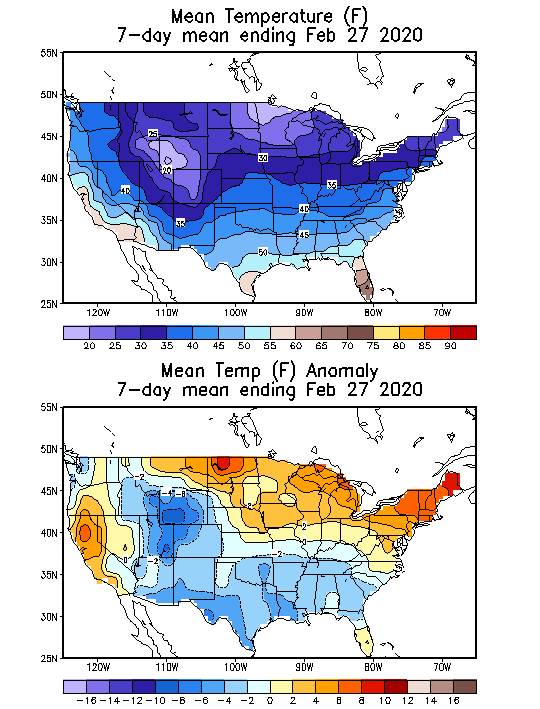
Source: National Oceanic and Atmospheric Administration
Deviation between average and normal (°F)
7-day mean ending Feb 27, 2020

Source: National Oceanic and Atmospheric Administration

